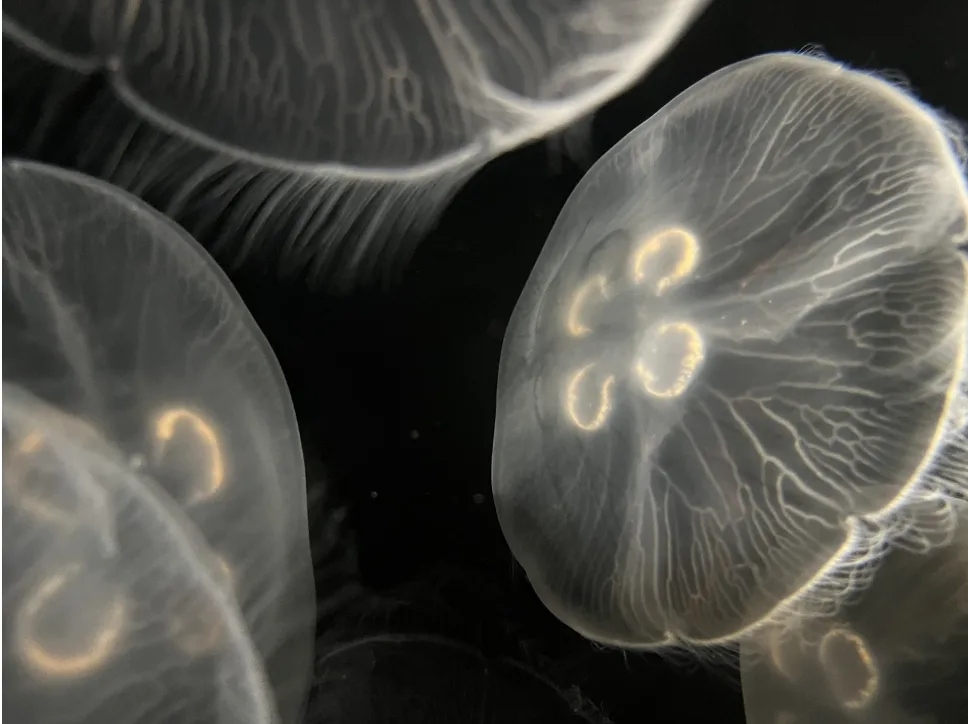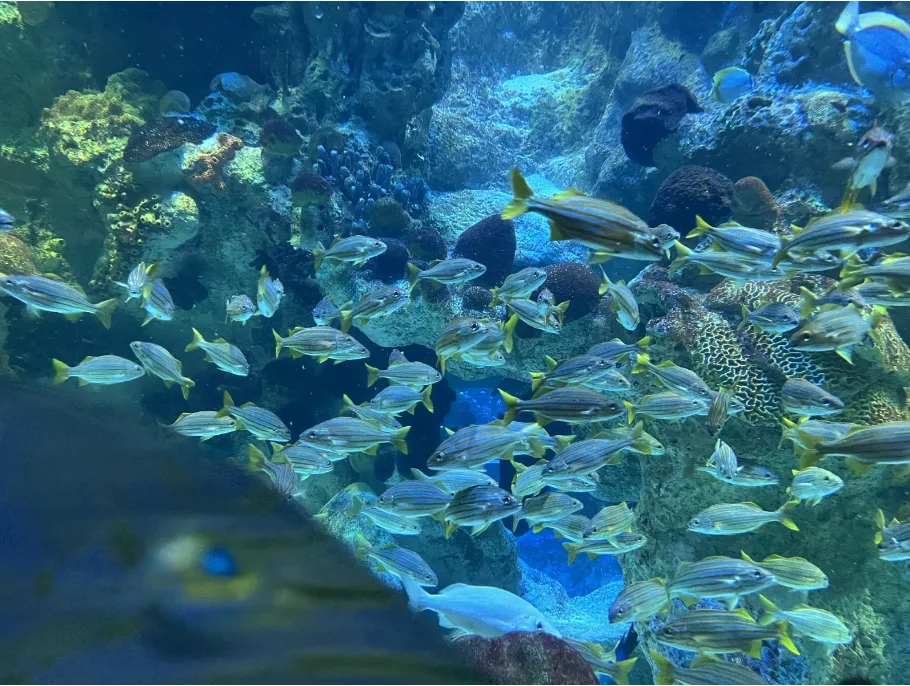Programs Blog
New England Aquarium and a Boston History Tour

Date: September 17, 2024
Location: SEA Campus, Woods Hole, MA
Weather: 72℉, partially cloudy with a nice breeze
My name is Cayla Ossen-Gutnick. I’m from Hastings-on-Hudson, NY (a small town about 35 minutes north of NYC right on the Hudson River), and I am currently a senior at Mount Holyoke College majoring in Environmental Studies with a certificate in Coastal and Marine Science. This is actually not my first SEA program. One summer back in high school, I participated in a 2-week SEA Expedition program where I sailed from Woods Hole to Boston. That was an incredible experience, and I am so happy to be back at SEA, this time for a whole semester.
Despite having a ton of other work to do, I’ve been really excited about being the person to write today’s blog post, because I get to report on our trip to Boston last Friday! And of course, the New England Aquarium. If you want the short story of the New England Aquarium, we saw seals, African and Southern rockhopper penguins, sea turtles, many species of invertebrates, and fish…lots and lots of fish; but if you want to hear more about the aquarium, definitely don’t skip over the next paragraph of this blog post because I’m about to go into some serious detail.
One thing we’ve been doing at the beginning of each OGC (Ocean & Global Change) class has been pulling up Coral Morphologic’s Coral City Camera, which livestreams the view from underwater cameras placed on various coral reefs around Miami. Looking at this livestream has been really helpful in learning about the different types of fish and invertebrates you can find on Caribbean reefs, as well as how to identify them. The skills and knowledge gained from that activity are going to be vital to the research we’ll be doing in the Caribbean, as the data we are going to collect includes information on benthic community composition and the biodiversity and abundance of reef fish species.
One of the main attractions in the New England Aquarium is their Giant Ocean Tank, which features Caribbean marine life, including rays, sea turtles, hundreds of reef fish, and a nurse shark. At four-stories tall and containing 200,000 gallons of seawater, that tank really is Giant (with a capital G). Getting to walk up and down the spiral ramp that surrounds it provided a great opportunity for us to practice our reef fish identification skills (and take a lot of fish photos). Just a small fraction of the reef fish species we saw includes French grunts, hogfish, barracuda, queen angelfish, spotfin butterflyfish, smooth trunkfish, sargassum triggerfish, porkfish, and lookdowns. So yeah, a lot of fish…but where did the New England Aquarium get all of them?
An aquarium educator explained how and from where the New England Aquarium sources their fish and other marine life, which was really interesting to learn about. Some animals, like the harbor seals out in front of the aquarium and the sea turtles inside the Giant Ocean Tank, were rescued and came to the aquarium when it was determined that they were not good candidates for release back into the wild. This could be for a variety of reasons. Out of the three turtles in the Giant Ocean Tank, one was 90% blind, one was from an aquarium that shut down, and the last one had neurological damage and couldn’t pass their foraging test. As for the fish, they are sourced through a combination of the aquarium’s larval fishes program (raising their own reef fish in captivity), trades with other AZA (Association of Zoos and Aquariums) accredited zoos and aquariums, and if a certain species isn’t able to be bred in captivity, some fish are taken from the wild from healthy populations (…or so they say). Later in the day, this was actually one of the topics on the table of a spirited, yet friendly debate between some of us students on the ethics, purpose, and efficacy of aquariums for conservation initiatives and the education of the general public on ocean ecosystems. It was a really exciting thing to talk about and debate, but since the conversation continued past lunch, it did spill over into our history walk around Boston for a little.
That history walk, with our Marine Environmental History professor, Craig Marin, was also a highlight of the Boston trip. I’ll admit, I was a little apprehensive about it at first. It was hot out, I made the mistake of not wearing sneakers, and the thought of walking around Boston and baking in the sun wasn’t exactly appealing. We started at the site of the Boston Massacre, something I’d learned about numerous times before and wasn’t the most enthusiastic about learning about it again. However, Craig’s explanation introduced a lot of nuance and background for the situation that I found myself excited to learn more about. We talked about the Massacre, what depictions there were of it, different accounts of what happened, common misconceptions, and then we got into the root of why it started. This was part of the story I hadn’t learned before. I didn’t know about the service that was provided to the British soldiers that was unpaid; I didn’t connect the dots between the growing tensions of the time and that this event was just a spark that ignited them. Craig is such an amazing professor. Even though I wouldn’t consider myself a history buff, everything he’s taught us has been so interesting. I should’ve never doubted him. As an Environmental Studies major, our next stop on the tour was especially exciting for me because we started our discussion on Boston’s changing waterfront. Maps of Boston’s waterfront from the 1700s look very different to maps of Boston today. Filling in the land between 2 docks was a common practice to increase one’s waterfront land, and as a result, the coastline was expanded. Now, with the threat of sea level rise, this has posed a big challenge for the city, as there are some areas near the waterfront that are actually below sea level. We also talked about the changing uses for the waterfront and the more recent initiatives to increase greenspace and public access along the waterfront. We then started our long walk to where the van was parked, although we had a few quick stops to point out a pop-up exhibit on the changes that have occurred to Boston Harbour over the years, see the site of the Great Molasses Flood of 1919, and of course, to get ice cream.
I would like to take a moment to thank our amazing professors, Craig, Heather, and Rich, as well as our Program Assistant, Sydney, for putting together such an amazing field trip! Also, a quick shout-out to my parents (I miss you guys!), and to my boyfriend, Nick, for always being there to listen to me talk (often for a very long time) about everything I’ve learned and experienced here at SEA!
Cheers,
Cayla 🐠

Recent Posts from the Ships
- Ocean Classroom 2024-A collaborative high school program with Proctor Academy
- Collaborations and Long-term Commitments: SEA’s Caribbean Reef Program Sets a Course for Coastal Programs that Compliment Shipboard Experiences.
- Sea Education Association students prepare for life underway using state of the art nautical simulation from Wartsila Corporation.
- SEA Writer 2022, Magazines From the Summer SEA Quest Students
- Technology@SEA: Upgrades Allow Insight into Ocean Depths
Programs
- Gap Year
- Ocean Exploration
- High School
- Science at SEA
- SEA Expedition
- SEAScape
- Pre-College
- Proctor Ocean Classroom
- Protecting the Phoenix Islands
- SPICE
- Stanford@SEA
- Undergraduate
- Climate and Society
- Climate Change and Coastal Resilience
- Coral Reef Conservation
- Marine Biodiversity and Conservation
- MBL
- Ocean Exploration: Plastics
- Ocean Policy: Marine Protected Areas
- Oceans and Climate
- Pacific Reef Expedition
- The Global Ocean: Hawai'i
- The Global Ocean: New Zealand